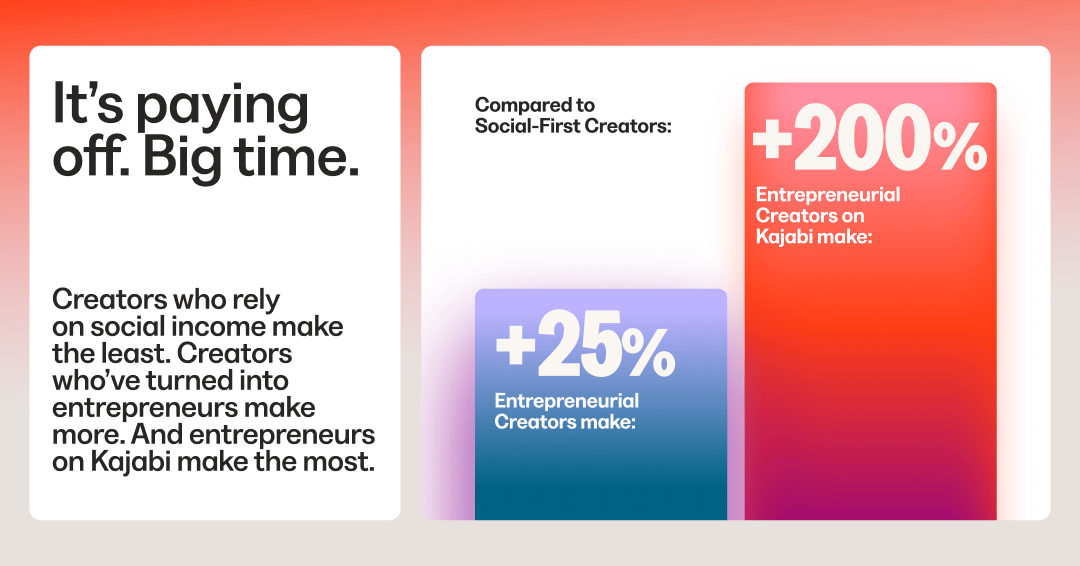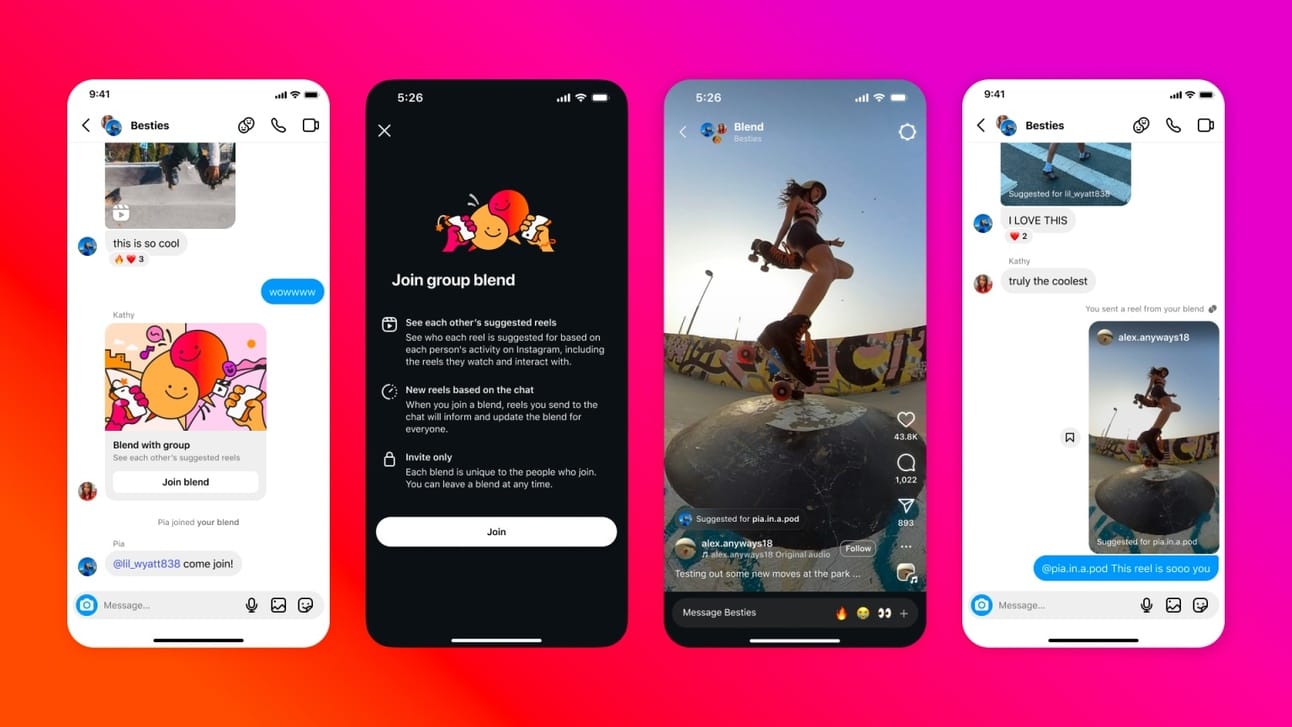IN PARTNERSHIP WITH
TODAY’S EDITION
A new report from Kajabi reveals how creators are finding success off social media in 2025.
Instagram lets users share a feed of suggested Reels with Blend.
TikTok announces its iteration of Community Notes with FootNotes.
DEEP DIVE
The State of Creator Commerce: How Creators Are Finding Success in 2025
The creator economy is full of contradictions: it's worth hundreds of billions of dollars with immense potential, yet creators continue to build careers on platforms that benefit far more from their content than they do.
But 2025 is showing signs of a bigger shift. A new report from Kajabi, The State of Creator Commerce, offers an in-depth look at the evolution happening right now.
It breaks down how creators are shifting away from platform dependency and toward full-fledged entrepreneurship: building revenue streams they own, prioritizing direct audience relationships, and treating their work as a business—not just a personal brand.
According to the report, 59% of creators now identify as entrepreneurs, up from 50% the year prior. These are Entrepreneurial Creators: individuals who build audiences on social media but don’t rely on it for income. Instead, they invest in their own products, courses, coaching programs, and memberships, where they own and control their revenue streams. And they’re growing fast.
That’s a stark contrast to Social-First Creators, who rely almost exclusively on social media income, like platform payouts and brand deals.
Below, I unpack key insights from Kajabi’s report that show how creators are moving beyond platform dependency, embracing entrepreneurship, owning their audiences, and prioritizing sustainable, and diversified revenue streams and what that means for the future of the creator economy.
Platform Volatility Is Accelerating the Move Toward Ownership
Creators have always operated at the mercy of social platforms, dealing with algorithm changes, shadow bans, inconsistent payouts, policy shifts, and even platform bans. But the risks feel sharper than ever. Just look at the uncertainty surrounding TikTok right now.
Kajabi’s report found that fear around platform volatility has surged 200% year-over-year among Social-First Creators, whose income depends heavily on brand deals, ad revenue, and affiliate commissions.
In fact, Social-First Creators are 4x more worried about a TikTok ban than Entrepreneurial Creators. That makes sense: when your livelihood can disappear overnight because of a government decision or algorithm tweak, it’s tough to build long-term.
Creators are also more conscious of the brands they partner with, with a 40% year-over-year decrease in creators willing to compromise their values for high-paying brand deals. Whether it’s the quality of a product or service or a brand's social or political stance, not being solely dependent on social media revenue, particularly from brand deals, gives creators more power to live by their values and have the ability to say no.
Diversified Income Streams Are Outperforming Platform-Dependent Models
Traditional creator revenue streams like brand deals, affiliate marketing, and platform payouts are in decline. Brand deals alone are down 52% year-over-year. Meanwhile, revenue from owned and managed channels is growing:
Podcast revenue: up 47%
Digital downloads: up 20%
Educational content: up 14%
Memberships: up 10%
This shift isn’t just about chasing new trends. It’s about regaining control. Creators who diversify their income into owned channels are seeing meaningful financial and personal benefits. According to the report, Entrepreneurial Creators earn 25% more than Social-First Creators, and creators using Kajabi specifically earn 200% more.
It goes beyond money, too. Entrepreneurial Creators report better work-life balance, more creative freedom, and greater control over their schedules. These are many of the things that initially attract people to this path but often feel out of reach under a platform-dependent model.
On the flip side, 33% of Social-First Creators report negative impacts from algorithm changes, and 26% struggle with financial stress.
Audience Ownership and Niche Focus Are Powering Sustainable Growth
Creators are increasingly turning to owned channels and products to build more stable businesses. According to Kajabi, the top monetization methods for Entrepreneurial Creators include:
Educational content
Coaching/consulting
Memberships
Merchandise
Digital downloads
Audience ownership is a key success driver—55% of Entrepreneurial Creators say it’s critical to their business. Owning email lists, communities, or even mobile apps enables creators to build deeper, direct relationships with their audience, free from algorithmic reach. This is one reason I launched my email newsletter years ago and have since built consulting, workshops, and a paid tier around it. The direct relationship makes a difference.
Community is another major differentiator. Creators who offer community features earn 2x more than those who don’t. Niche specialization is also proving essential. 57% of Kajabi creators believe having a niche is critical, compared to just 22% of Social-First Creators. Niche-focused creators tend to have more engaged audiences and are better positioned to launch high-value offerings like courses, memberships, or coaching.
And when creators own their channels, they can be strategic with pricing, offering one-time payments, subscriptions, or bundled services. Compare that to social media platform revenue, where pricing is often tied to deliverables, follower count, or time, which are factors that don’t always reflect the full value of the creator’s work.
Final Thoughts
The creator economy has always been full of promise. But for too long, too many creators have built on borrowed ground, growing massive audiences without reaping the full rewards. Kajabi’s State of Creator Commerce report captures a major shift in motion: creators stepping into the role of business owners, building long-term revenue streams, and taking back control of their time, income, and creative freedom.
Social platforms are important to creators because they’re powerful tools for discovery. But they shouldn’t be the foundation of a creator’s business. The creators thriving in 2025 and beyond are those thinking like entrepreneurs, using platforms like Kajabi to turn their audience into customers, their skills into scalable products, and their content into sustainable businesses.
For more insights on how creators are finding success beyond social media through digital products, online communities, and more, check out the full State of Creator Commerce report. And if you're ready to own and monetize your audience, start your journey with Kajabi.
NEWS, TRENDS & INSIGHTS
Instagram launched Blend after recently testing the feature. Accessible via a Direct Message thread, it’s an opt-in shared feed of suggested Reels between users, one-on-one or in a Group Chat. Suggestions are based on what users watch, interact with, and share. It’s another move leaning into content discovery via DMs.
Instagram is testing “Latest” and “Most Viewed” filters in the Reels tab of profiles. Viewers can sort Reels by publish date or popularity from the top of the tab. Similar to TikTok, this helps users discover content from specific accounts in new ways. It’s useful for marketers scouting talent and creators identifying their top-performing content.
Instagram is showing view counts on posts and Reels. Users can see view counts on their own grid posts, while anyone can view counts on the Reels tab, unless turned off. This helps creators quickly gauge performance without digging into analytics.
YouTube rolled out Automatic Dubbing to all channels in the YouTube Partner Program. Enabled by default, it generates translated audio tracks in multiple languages. While there are limitations, it’s a notable step in making content more accessible by breaking down language barriers.
YouTube expanded automatic location tagging for travel and restaurant-related Shorts. Using the title, description, and other details, YouTube will apply location tags as overlays. With Instagram and TikTok growing as search engines, this move aims to connect Shorts viewers to real-world places and boost local discovery.
YouTube put out an open call to creators for upcoming search studies. It’s seeking livestreamers, podcasters, Shorts creators, and Shopping affiliate program participants who speak English, Japanese, or Indonesian. This signals YouTube’s deeper focus on these areas through direct creator input.
TikTok announced Footnotes, its version of Community Notes. Starting in the U.S., Footnotes contributors can add relevant context to short-form videos. Unlike X and Meta, TikTok is keeping fact-checking, making Footnotes a complementary tool to reduce misinformation and harmful content.
TikTok added more Brand Suitability controls. Advertisers can now exclude specific creator profiles and videos from certain ad campaigns. This helps brands avoid content that doesn’t align with their values, making it easier to maintain brand safety.
WHAT I’M READING
8 revelations from Mark Zuckerberg's 3 days on the witness stand in Meta's antitrust trial (Business Insider)
Meta's antitrust trial has uncovered several notable revelations from Zuckerberg and Co. These include a proposal to purge all Facebook users' friends, an attempted $6 billion acquisition of Snapchat, his admission that TikTok’s growth is impacting Meta’s business, and the claim that Facebook isn’t for friends anymore despite its revamped Friends tab, and more.
Revolve faces $50-million lawsuit alleging influencers hid paid brand partnerships (The Los Angeles Times)
The retailer, along with its affiliate partners and three influencers, is facing a $50 million lawsuit for failing to properly disclose sponsored posts, often just tagging the fashion brand instead of using clear language. This serves as a reminder that disclosure isn’t optional, as skipping it risks not only audience trust but also serious legal and financial consequences.
From epic edits to quick clips: Transitioning your long-form content to YouTube Shorts (YouTube Blog)
YouTube outlines how creators can turn their long-form videos into Shorts, from selecting the right segments to creative best practices and experimentation.
OpenAI is building a social network (The Verge)
The AI giant is reportedly working on its own social media platform to rival X and Threads, including an internal prototype centered on ChatGPT’s image-generation features that have gone viral, along with a social feed.
THANK YOU
Support the Newsletter: If you're getting value from the newsletter and want to support, you can do so in a few ways: share it with a colleague, contribute via Buy Me A Coffee, or upgrade to the paid tier.






